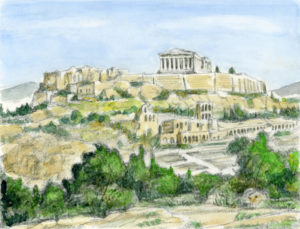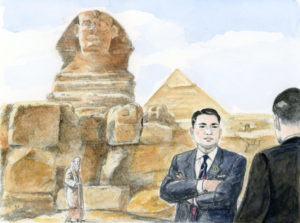Chapter Summary

Illustration courtesy of Seikyo Press.
On February 2, Shin’ichi and his companions arrived in Turkey. Looking back on the history of relations between Japan and Turkey, he observed that although diplomatic relations between nations are important, the ties between their people are fundamental.
While in Turkey, they visited the Dolmabahçe Palace and other sites.
The group traveled onward to Greece on February 4, where they toured the Acropolis and visited the site believed to be Socrates’ prison. Shin’ichi contemplated on democracy and observed: “Helping the people to become wise . . . is the key to achieving true democracy. And that is the task to which we in the Soka Gakkai are devoted” (The New Human Revolution, vol. 6, p. 90).
At their next destination, Egypt, Shin’ichi and his travel partners saw the pyramids of Giza. When he returned to his hotel, a telegram was waiting for Shin’ichi that read “No Appeal.” This meant that the prosecutors in the Osaka election incident trial,[1] who had sought Shin’ichi’s conviction, decided not to appeal his not-guilty verdict in Osaka District Court. Shin’ichi’s innocence in the case was now settled.
On February 11, Shin’ichi celebrated the birthday of Josei Toda, his mentor, in Pakistan. Recalling that Alexander the Great ended his eastward expedition in what is now Pakistan, Shin’ichi stated: “Leaders, no matter how great, can achieve nothing lasting unless others understand and share their goals, working together to realize them. True comrades, true disciples, are linked throughout life by a shared aspiration” (NHR-6, 115).
He reaffirmed his determination to advance on the long march toward kosen-rufu, which President Toda had entrusted to him.
As he headed back to Japan, Shin’ichi stopped in Thailand and also had a layover in Hong Kong. In both places, he announced the formation of new chapters.
Unforgettable Scene

Illustration courtesy of Seikyo Press.
The Will of the People Is the Source of Great Achievements
On February 7, 1962, Shin’ichi Yamamoto visited Egypt’s Great Pyramid of Khufu, where he shared his insights into the construction of the pyramid with the youth accompanying him.
Herodotus’ account resulted in the long and widely held belief that the pyramids were built by cruel forced labor.
“The reason I have my doubts about Herodotus’ account,” Shin’ichi said, “is that I don’t believe anything that people were pressed into building against their will would survive like this for thousands of years” …
“The fact that Khufu’s pyramid still stands means, to me at least, that the workers felt motivated to do their best by a strong sense of personal responsibility. Moreover, it would have been impossible to build the pyramid without tremendous unity of purpose, mutual cooperation and assistance.
“Where would such dedication, such enthusiasm for building this pyramid, come from? Certainly not from forced or slave labor. I think that the construction of the Great Pyramid strongly reflects the will of the people.”
■ ■ ■
In 1983, some twenty years later, when Shin’ichi spoke with the distinguished French Egyptologist Jean Leclant, he confirmed that his intuition was not mistaken. Recent studies indicate that the Great Pyramid was not built by slaves but by free citizens. (NHR-6, 95–96)
Key Passage
People tend to forget their old friends. Or, if they keep in touch with their old friends, they tend to hesitate to make new friends. But by both valuing our old relationships and making new ones, we constantly open ourselves to new possibilities. (NHR-6, 70)
References
- Osaka Incident: The occasion when SGI President Ikeda, then Soka Gakkai youth division chief of staff, was arrested and wrongfully charged with election law violations in a House of Councillors by-election in Osaka in 1957. In the court case, which began on October 17, 1957, and concluded on January 25, 1962, he was fully exonerated of all charges. ↩︎
You are reading {{ meterCount }} of {{ meterMax }} free premium articles

